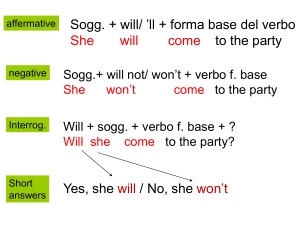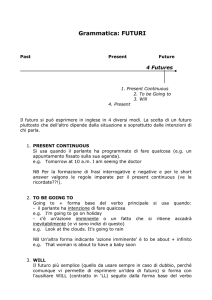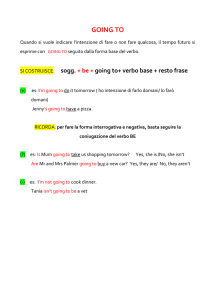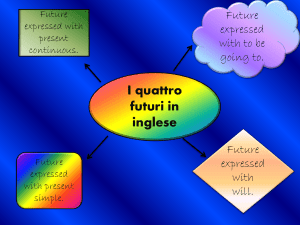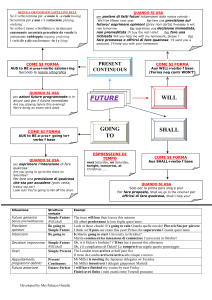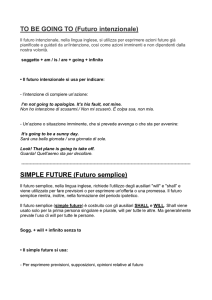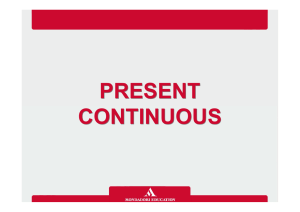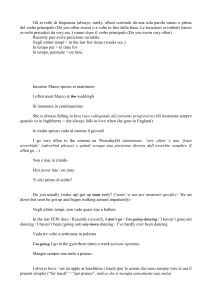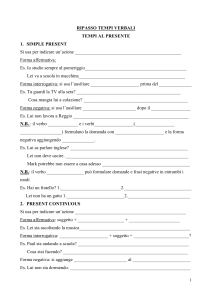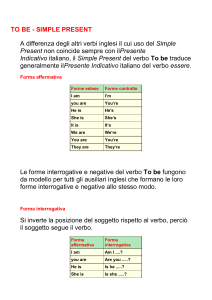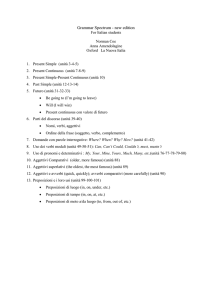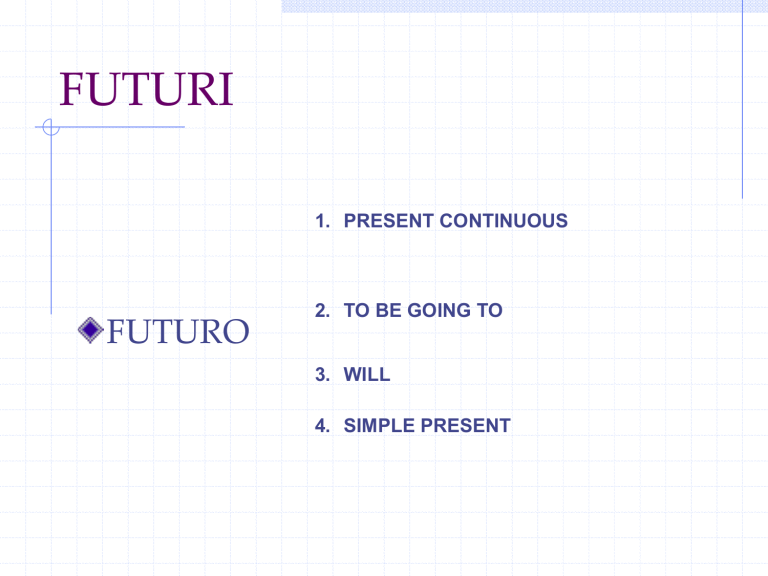
FUTURI
1. PRESENT CONTINUOUS
FUTURO
2. TO BE GOING TO
3. WILL
4. SIMPLE PRESENT
1) PRESENT CONTINUOUS
Il Present Continuous con valore di futuro si usa:
per indicare quelle azioni che si è deciso nel passato di
fare nel futuro
e.g La banca ha chiamato Steven e gli ha chiesto di
iniziare a lavorare per loro la prossima settimana.
Ora puoi dire:
The bank called Steven last week. He’s starting
a new job next week.
AZIONI PROGRAMMATE I.E PIANI
PRESTABILITI CHE DIFFICILMENTE
VERRANNO MODIFICATI
e.g. she is starting a new job next week
Per la formazione delle frasi interrogative, negative e delle short
answers cfr. Present Continuous
Il Present Continuous con valore di futuro è spesso
accompagnato da un’espressione di tempo come
next week, tomorrow, on Tuesday etc.
PRESENTE= I’m leaving (=sto partendo ora)
FUTURO
I’m leaving tomorrow
Si usa il Present Continuous per fare domande sui
PROGETTI delle persone:
e.g. What are doing next year?
MA non si usa per indicare eventi futuri che non
abbiano deciso e che non dipendono da noi:
QUINDI
NON: The sun is shining tomorrow
MA: The sun will shine tomorrow
2) TO BE GOING TO
VERBO TO BE CONIUGATO + GOING TO +
INFINITO del VERBO PRINCIPALE
senza il TO
e.g. I am going to have a break
TO BE
CONIUGATO
GOING
TO
INFINITO
VERBO CHE
INDICA
L’AZIONE
SENZA TO
AFFERMATIVA
I am
He/she/it is
We/you/they are
NEGATIVA
I am not
He/she/it is not
We/you/they are not
INTERROGATIVA
Am I
Is he/she/it is
Are we/you/they
going to leave (?)
Di solito vengono utilizzate le forme contratte del
verbo to be
e.g. They’re going to leave
Con I, la forma contratta è “I’m not going…”
Con he/she/it ci sono due forme contratte:
1) he/she/it isn’t going to…
2) he/she/it’s not going to…
Con you/we/they ci sono due forme contratte:
1) you/we/they aren’t going to…
2) you/we/they’re not going to…
USO
1) QUANDO CHI PARLA HA INTENZIONE DI FARE
QUALCOSA:
e.g I am going to visit Paul in Brighton tomorrow
2) PER FARE PREVISIONI SUL FUTURO, QUANDO
CI SONO INDIZI CHE CI DICONO CHE UN
FATTO ACCADRÀ INEVITABILMENTE – IDEA DI
AZIONE IMMINENTE:
e.g. Look at those clouds! It’s going to rain
That man on the ladder is going to fall off! (you
see that the ladder is broken)
3) WILL
Il futuro generalmente (i.e. quello da
utilizzare se in dubbio) si forma con
L’AUSILIARE WILL + VERBO PRINCIPALE
(all’infinito senza il to)
FORMA
CONTRATTA ( ‘LL)
e.g. I will go.
AFFERMATIVA
I WILL/ ‘LL
He/she/it WILL/ ‘LL
We/you/they WILL/ ‘LL
stay.
NEGATIVA
I WILL NOT/ WON’T
He/she/it WILL NOT/WON’T
We/you/they WILL NOT/ WON’T
stay.
INTERROGATIVA
WILL I
WILL he/she/it
WILL we/you/they
stay?
USO
- Tutte le volte che non si riconosce un programma
o un’intenzione.
- Quando si prende una decisione sul
momento/improvvisa – ie si decide sul momento
e spontaneamente di fare qualcosa.
e.g. se il campanello suona, si dice:
I’ll open the door. (Apro io la porta)
- Quando ci si impegna a fare qualcosa
No one’s offered to drive you to the airport? I’ll drive
you there!
- Per fare previsioni, per parlare di ciò che
pensiamo, speriamo o crediamo accada nel
futuro (quindi con verbi come O THINK, TO
BELIEVE, TO HOPE, TO BE SURE ETC.)
e.g.
I think I’ll have pizza tonight
I hope that in the future, everyone will live in
peace.
-E
anche quando queste previsioni sono fatti
futuri certi
e.g. He’s a good manager. He won’t do any mistake.
SHALL
Potremo trovare SHALL al posto di WILL
con I o WE quando:
ci offriamo di fare qualcosa per un’altra
persona
e.g. Shall I make you a cup of coffee?
diamo un suggerimento su cosa
possiamo fare
e.g. Shall we see a film tonight?
4) SIMPLE PRESENT
orari, programmazioni etc.
e.g. The train leaves at 4.30 pm (timetable)

